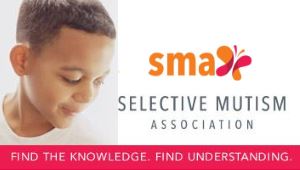Blog
Treating Selective Mutism
How to Treat SM: Effective Research-Based Treatments for Selective Mutism
Selective Mutism Treatment Options
Treatment for selective mutism (SM) can include psychotherapy and medication to address the anxiety that underlies the person’s inability to speak in certain situations. Some children with selective mutism also benefit from speech-language therapy and other interventions recommended by the main treatment provider(s).
In psychotherapy, a psychologist or other professional will use some of the following approaches, depending on the individual child.
Behavioral and Cognitive-Behavioral (CBT) Strategies
These are the most widely supported psychological treatments for selective mutism. Behavioral strategies refer to coming up with a step-by-step plan where the child gradually performs increasingly difficult speaking-type behaviors coupled with positive reinforcement whenever the child accomplishes those behaviors. There are several behavioral strategies that when used together are most effective in supporting a child’s improvement in speaking, including:
- Contingency management uses positive reinforcement to reward verbal behavior, which may include initial reinforcement of nonverbal communication like pointing and whispering.
- Shaping reinforcement is provided for approximations of the target verbal behaviors (e.g., mouthing words, whispering, talking on the telephone) and later for normal speech. A reinforcement menu containing the types of rewards the child wants to earn and for which behaviors should be first developed in collaboration with the child.
- Stimulus fading interventions build on the success of contingency management and shaping reinforcement strategies by gradually increasing the number of people and places in which speech is rewarded. For example, the child may first be rewarded for speaking to a classmate with whom they already speak outside of school. Gradually, other students are introduced into the group until the child is able to speak in the presence of a large group of peers. Stimulus fading can also be used in problematic situations that occur outside of school (e.g., talking to grandparents, ordering in restaurants).
- Systematic desensitization traditionally involves the use of relaxation skills along with gradual exposure to successively more anxiety-provoking situations. In this type of intervention, a hierarchy of feared speaking events is constructed and therapy consists of a series of imagined and in vivo (real-life) exposures to feared situations.
- Social skills training may also be used to reduce anxiety and facilitate speech with peers. This involves learning what to say to initiate conversations, how to take turns, how to make eye contact, and how to understand another person’s nonverbal behavior.
- Self-modeling involves making video or audio recordings that have been edited to depict the child speaking successfully in settings in which they have been showing difficulty communicating. The child watches these video segments during a positive verbal interchange (often at home) and then visually, through playback, carries the communicative interchange into another, often more challenging, setting. The recordings are played repeatedly throughout the intervention with the expectation that the child will become accustomed to hearing themself speaking in these settings and begin to believe in their ability to do so.
Cognitive strategies, which involve identifying anxious thoughts that contribute to the nonverbal or avoidance behaviors, can also have a positive impact for those with selective mutism. Introducing cognitive strategies is most useful for children aged seven and older when they have developed the ability to become better aware of their thoughts. Cognitive techniques include:
- Recognizing body symptoms of anxiety (e.g., heart beating fast, shortness of breath, flushed cheeks)
- Identifying and challenging maladaptive beliefs (e.g., “Everyone will laugh at me if I speak due to the sound of my voice”)
- Developing a coping plan to deal with distress (e.g., generating calm thoughts, and problem solving how to cope)
For example, many children with selective mutism have anxious thoughts about or worry that people will make fun of their voice or what they want to say. Cognitive therapy teaches the child to understand that those thoughts are the product of worry—and therefore are not real threats—and teaches them to self-coach by thinking positive thoughts instead. Cognitive strategies should be added to behavioral strategies at a point in time determined by the treatment provider.
Treatment Methodologies with an Evidence Base that Incorporate these Behavioral Strategies
Several protocols have included a variety of these behavioral components that have been found to be effective in reducing SM behaviors and anxiety across settings. We highlight these specific treatments below.
- Integrated Behavior Therapy (IBT) for SM (Bergman et al., 2013) conducted the first controlled trial of SM treatment, and found strong support for a six-month, 20-session, weekly behavioral treatment that centered on graduated exposure to verbal communication (through a “talking ladder” in the clinic, school, and home environments. It further incorporated a reward chart, cognitive restructuring (for those youth for which it was developmentally appropriate), and parent involvement. 75% of treated children were deemed treatment responders by independent evaluators masked to treatment condition.
- Defocused Communication (e.g., using a pleasurable activity to foster joint attention with child typically side by side rather than on focusing solely on the child) was a key component of another 3-month behavioral intervention examined by Oerbeck and colleagues (2014) who conducted a randomized trial with 24 children aged three to nine years, finding significant improvements in the intervention group at school in comparison to a waitlist control. These findings continued at a 1-year (Oerbeck et al., 2015) and 5-year follow up (Oerbek et al., 2018).
- Parent Child Interaction Therapy for SM (PCIT-SM) is another behavioral approach that incorporates multiple elements to foster significant improvement in speech behaviors and reduction in anxiety using individual (Catchpole et al., 2019) and group intensive formats with real-world application (Cornacchio et al., 2019, Furr et al., 2020; Lorenzo et al., 2021). This protocol adapted from traditional PCIT (Eyberg & Funderburk, 2011) and includes two phases, Child-Directed Interaction (CDI) and Verbal-Directed Interaction (VDI), which combine positive attention skills to reinforce wanted behavior (e.g., brave, approach-oriented behavior and verbal responding) and prompting for verbalizations from children in very specific ways and sequences to optimize the likelihood that a child will respond verbally. This is combined with gradual exposure to social and speaking situations that vary across person, place, or activity.
- Social Communication Anxiety Treatment (S-CAT ®; Shipon-Blum, 2010) is a brief multimodal approach, that incorporates the use of cognitive-behavioral and insight-oriented strategies through advancing youth across the SM-Social Communication Comfort scale (SCCS) or Social Communication Bridge to increase social communication. This treatment also involves gradual exposure to varied situations in the home, school, and in the community and works to transfer control to the child. Significant gains have been found in speaking behavior as well as decreased levels of withdrawal amongst youth ages five to 12 years with selective mutism (Klein et al., 2017). Typically, this treatment is delivered individually, but recently has been conducted via groups.
Additional Therapy for Selective Mutism
Although other therapies commonly used with the behavioral and cognitive-behavioral tactics above are not necessarily researched or supported by research as yielding gains in children with SM, they do have merit. Most seek to increase a child’s self-esteem, strengthening them emotionally by reinforcing areas of competence, belonging, and acceptance as they complete the difficult work involved in these behavioral and cognitive-behavioral therapies. Such therapies include learning new skills and encouraging participation in sports, music, the arts, and more.
Treating Selective Mutism with Medication
A medical doctor such as a psychiatrist or pediatrician may prescribe medications to address the underlying cause of the child being nonverbal in certain situations: anxiety. Medication is most effective when combined with behavioral and/or other psychological strategies above, especially to help the child maintain improvement over time. In particular, selective serotonin reuptake inhibitors (SSRIs), such as Prozac, Paxil, Celexa, Luvox, and Zoloft, have been shown to help relieve anxiety conditions in youth. Additionally, several small-scale studies have shown these types of medications to effectively treat SM. In the few large-scale studies done, experts report that these medications have been very helpful and are largely safe. Starting the medication at a very low dosage and increasing it very gradually has been effective in keeping side effects to a minimum and usually avoiding them altogether. Thankfully, many children with SM respond to a very low dosage of these medications, but it is best to speak with the medical doctor to determine the appropriate dose for that particular child. When combined with appropriate behavioral or cognitive-behavioral therapy, the treatment success rates are dramatically higher.
Usually, a child prescribed medication for anxiety will take it for approximately 12 months, or to get through one entire school year. Over this time, the goal is to see a decrease in anxiety, greater comfort speaking in most settings, and continued improvement after medication stops. At the time of discontinuation, the medication should be tapered off slowly under doctor supervision to avoid any adverse side effects.
Although medication is not always necessary to treat SM, it usually helps the child take the first steps in overcoming their anxiety. Without reaching a more tolerable level of anxiety, most children will have difficulty making even small steps toward speaking. This is especially true if the child has exhibited symptoms of selective mutism for a long time, other available treatments have not helped the child improve, or in cases in which the child also shows symptoms of depression or other anxiety disorders. Medication is more likely to be prescribed in cases where the selective mutism is more severe or chronic (such as with older children and adolescents).
Speech-Language Therapy for Selective Mutism
Since speech and language impairments can co-occur with SM, speech-language pathologists (SLPs) may contribute to the treatment benefits of children with selective mutism. Additionally, SLPs are trained to work with children on pragmatic language skills, which can be greatly impacted by selective mutism. Simultaneously treating SM with both behavioral strategies to help a child feel more comfortable speaking and linguistically based activities to foster language development is recommended for children with SM who lack pragmatic language skills. As described above, SLPs may also use augmented self-modeling, the video-based technique, with promise for reducing anxiety when speaking (Kehle, Bray, Byer-Alcorace, Theodore, & Kovac, 2011).
SLPs may often follow a behavioral approach that includes setting goals with gradual increases in expectations. For example, The Ritual Sound Approach® (RSA), a component of Social Communication Anxiety Treatment (S-CAT®) by Dr. Shipon-Blum (2010), has been successful in helping children communicate with greater ease. The behavioral technique of shaping is used to help modify and shape specific phonemes into blended sounds that represent real words. This approach starts with voiceless speech sounds that require less vocal effort because they do not engage the vocal cords. Children feel air move in and out of their mouths as they breathe, blow, and cough. Thus, voiceless speech sounds such as /h/ (similar to breathing), /k/ (similar to a cough), /s/, /t/, /p/, etc. are used because they are less audible than vowels or voiced consonant sounds such as /z/, /d/, /b/, /g/, etc. This behaviorally based treatment helps the child think of sound-making from a mechanical standpoint (e.g., put lips together lightly, build up air pressure in the mouth, and puff out air to produce the sound /p/).
In many instances, coordinating voice and speech while thinking of what to say linguistically becomes difficult for children with SM due to anxiety. Therefore, non-speech tasks may be used to help the children gain control of voicing. Once the child has adequate vocal control in non-speech tasks, speech can be introduced slowly and systematically to allow for success. A typical progression is as follows:
- Communicate by pointing, gesturing, or nodding (use games, toys, and age-appropriate projects)
- Communicate by drawing or writing (use games requiring these modalities)
- Talk through a recording device that is played when out of the room and then when in the room (as comfort increases)
- Talk to another person who speaks for the child (in front of others with increasing distance from the person’s ear)
- Talk to others using sounds (may be blended to form words)
- Talk to others using rehearsed or scripted language with and without visual prompts (develop charts to play guessing games)
- Talks spontaneously using words or phrases
- Talks spontaneously using sentences
Children with SM who present with a language delay may benefit from treatment that includes basic vocabulary development, grammatical morpheme development, and work on sentence structure. For many children with SM, the goal will be to enhance social-pragmatic communication with work on enhancing descriptive language (vocabulary and describing), expository language (informing and explaining), narrative language (storytelling), and discourse for social communication (discussing and interacting).
SLPs may first work on nonverbal skills of social engagement and later include communication skills in joint activity routines. Speech articulation therapy may also be part of the treatment protocol for children who have speech production errors, either sound substitutions, distortions, omissions, or additions.
It should be noted that some children with SM believe they cannot speak in some settings and may not properly engage their respiration, voice, or articulation appropriately. Children with SM can get accustomed to not speaking and thereby assume the self-image of a child who does not talk (Omdal, 2007). This self-fulfilling prophecy is one that can persist without appropriate intervention. The earlier the intervention, the better!
Sources
Cohan, S.L., Chavira, D.A., and Stein, M.B. (2006). Practitioner Review: Psychosocial interventions for children with selective mutism: a critical evaluation of the literature from 1990–2005. Journal of Child Psychology and Psychiatry 47:11, 1085–1097.
Kehle, T.J., Bray, M.A., Byer-Alcorace, G.F., Theodore, L.A., & Kovac, L.M. (2011). Augmented self-modeling as an intervention for selective mutism. Psychology In The Schools, 49(1), 93-103.
Armstrong, S.L. and Klein, E.R. (2016). Speech-Language Therapy and Selective Mutism. Selective Mutism Association.
Omdal, H. (2007). Can adults who have recovered from selective mutism in childhood and adolescence tell us anything about the nature of the condition and/or recovery from it? European Journal of Special Needs Education, 22(3), 237-253.
Shipon-Blum, E. (2010). Transitional stage of communication. Retrieved from http://www.selectivemutism.org/wp-content/uploads/2016/06/Missinglink.pdf
Treatment Resources
Although more recently the number of treating professionals who are knowledgeable about and know how to treat SM has increased, in some areas there are still too few professionals to provide support to all who need it. Our goal is to spread awareness and education about this anxiety disorder so that more physicians, psychologists, psychiatrists, SLPs, and other medical professionals understand what selective mutism is and how to treat it. For families and individuals, educators, and professionals, here are some resources the SMA has put together for this purpose.
For Families & Individuals
Find a Treating Professional
Ask the Expert
For Educators & School Staff
Toolkit for Educators
For Treating Professionals
Professional SM Assessment Tools
Webinars




